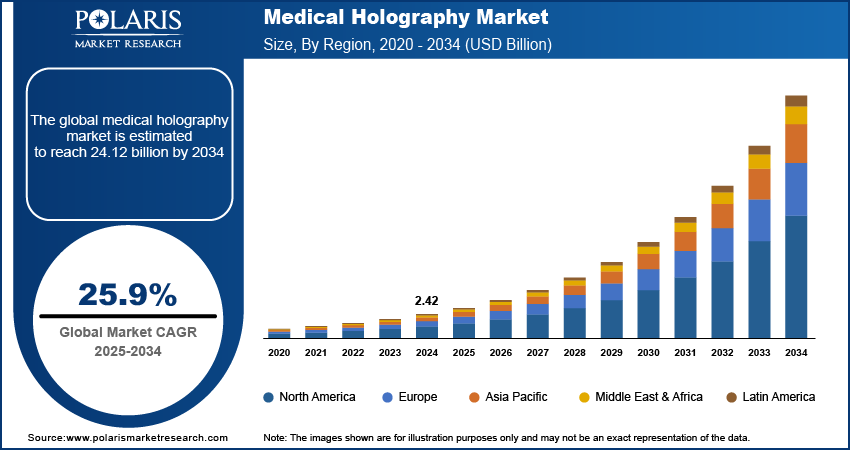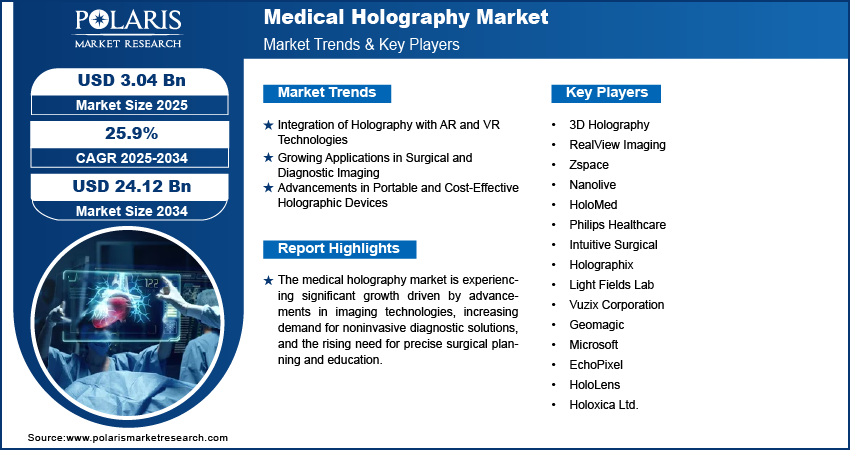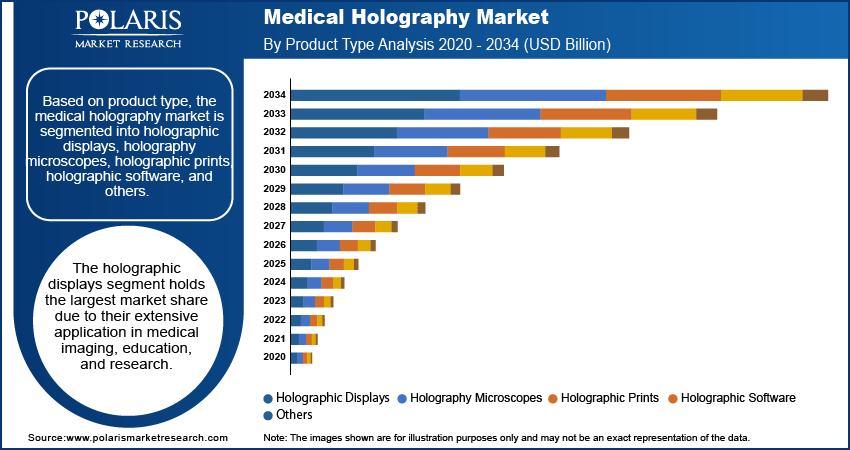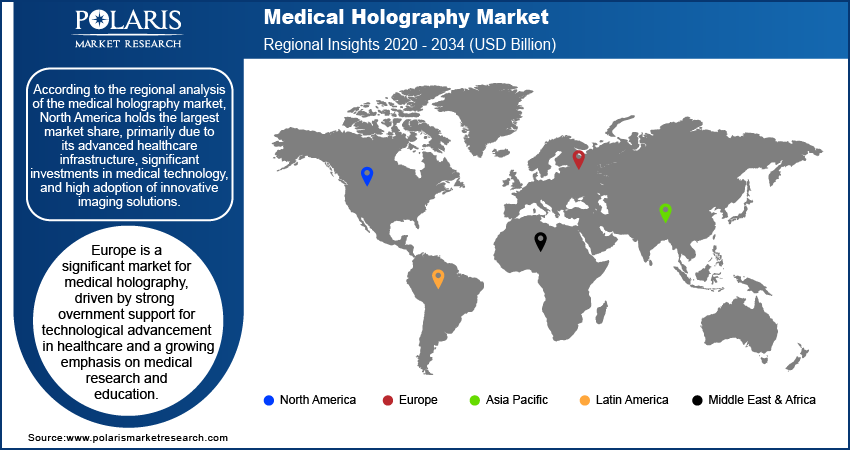
Medical Holography Market Size, Share, Trends, Industry Analysis Report: By Product Type (Holographic Displays, Holography Microscopes, Holographic Prints, Holographic Software, and Others), Application, End User, and Region (North America, Europe, Asia Pacific, Latin America, and Middle East & Africa) – Market Forecast, 2025–2034
- Published Date:Jan-2025
- Pages: 118
- Format: PDF
- Report ID: PM1739
- Base Year: 2024
- Historical Data: 2020-2023
Medical Holography Market Overview
The global medical holography market size was valued at USD 2.42 billion in 2024. The market is projected to grow from USD 3.04 billion in 2025 to USD 24.12 billion by 2034, exhibiting a CAGR of 25.9% during 2025–2034.
The global medical holography market encompasses technologies and solutions that utilize holographic imaging for medical applications, such as diagnosis, education, research, and surgery. The market growth is driven by advancements in imaging technology, increasing demand for minimally invasive procedures, and the growing adoption of holography in medical training and education. The rising prevalence of chronic diseases and the need for accurate visualization of complex anatomical structures further contribute to the market demand. Notable medical holography market trends include the integration of augmented reality (AR) and virtual reality (VR) with holographic systems and the development of portable and cost-effective holographic devices.

To Understand More About this Research: Request a Free Sample Report
Medical Holography Market Dynamics
Integration of Holography with AR and VR Technologies
The combination of holography with augmented reality (AR) and virtual reality (VR) is reshaping the medical sector, enabling enhanced visualization and interactivity. These technologies are increasingly being utilized in medical education and surgical planning, allowing practitioners to view 3D holographic models of organs or tissues overlaid in real-world settings. According to a 2023 survey by the National Institute of Health Technology, over 45% of healthcare institutions in developed countries have begun experimenting with AR- and VR-enabled holographic tools to improve patient outcomes. The trend highlights the potential for advanced, immersive technologies to transform traditional medical practices. Thus, the integration of AR and VR technologies with holography is expected to drive the medical holography market development in the coming years.
Growing Application in Surgical and Diagnostic Imaging
Holography is being widely adopted in surgical planning and diagnostic imaging to provide detailed, multi-dimensional views of patient anatomy. These tools are particularly valuable in neurology, cardiology, and orthopedics, where precision is crucial. A 2022 report published in The Journal of Medical Imaging revealed that the use of holography in pre-surgical planning reduces the margin for error by up to 30%, enhancing surgical success rates. This trend reflects the increasing reliance on holographic systems for accurate and noninvasive diagnostics. Hence, the rising application in surgical and diagnostic imaging fuels the medical holography market demand.
Advancements in Portable and Cost-Effective Holographic Devices
The development of portable and affordable holographic devices is democratizing access to advanced imaging technologies in healthcare. These devices are especially beneficial for resource-constrained settings and telemedicine applications, where access to traditional imaging tools may be limited. Research by the Global Health Innovation Alliance in 2023 showed a 25% year-over-year increase in the deployment of compact holographic imaging systems in low- and middle-income countries. This trend is making innovative diagnostic tools more accessible globally while supporting the expansion of telemedicine services. Therefore, advancements in portable and cost-effective holographic devices are expected to drive the medical holography market growth during the forecast period.

Medical Holography Market Segment Insights
Medical Holography Market Outlook – Product Type-Based Insights
By product type, the medical holography market is segmented into holographic displays, holography microscopes, holographic prints, holographic software, and others. The holographic displays segment holds the largest market share due to their extensive application in medical imaging, education, and research. These displays provide high-resolution, three-dimensional visualization of anatomical structures, which is increasingly valued in surgical planning and diagnostics. The adoption of holographic displays is further driven by technological advancements that enhance image quality and integration with other healthcare technologies, such as AR and VR systems.
The holography microscopes segment is registering the highest growth rate within the market owing to their rising use in cellular imaging and pathology studies. These microscopes enable researchers and clinicians to examine live cells and tissues in 3D without invasive procedures or staining. This capability is crucial for understanding complex biological processes and accelerating drug development. Additionally, holographic software is gaining traction as it complements hardware solutions by enabling better data analysis and visualization, creating a seamless ecosystem for medical holography applications.
Medical Holography Market Assessment – Application-Based Insights
The medical holography market segmentation, by application, includes imaging in medical indications, medical education, and others. Imaging in medical indications accounts for the largest market share due to its significant role in diagnostics, surgical planning, and monitoring of chronic conditions. This segment benefits from the increasing demand for precise, noninvasive imaging techniques that provide enhanced visualization of internal organs and structures. The adoption of holographic imaging systems is particularly prominent in neurology and cardiology, where detailed 3D representations are critical for improving diagnostic accuracy and surgical outcomes.
The medical education segment is growing at the fastest rate, driven by the need for advanced learning tools that enhance the understanding of complex anatomical and physiological concepts. Holography is transforming traditional medical training by enabling interactive, immersive experiences for students and professionals. Educational institutions and training centers are increasingly investing in holographic solutions to simulate real-world scenarios, allowing for improved skill development and knowledge retention. This trend is further supported by collaborations between medical institutions and technology providers to develop tailored educational platforms.
Medical Holography Market Evaluation – End User Insights
By end user, the medical holography market is segmented into hospitals and clinics, biopharmaceutical companies, and others. The hospitals and clinics segment holds the largest market share due to the extensive application of holographic technologies in diagnostics, surgical planning, and patient education. These institutions increasingly rely on advanced imaging solutions to enhance clinical outcomes and streamline complex procedures. The integration of holography into surgical suites and diagnostic departments highlights its growing importance in modern healthcare infrastructures, particularly in specialized fields such as cardiology and oncology.
The biopharmaceutical companies segment is witnessing the highest growth within the market, driven by their increasing adoption of holography for research and development purposes. Holographic imaging is revolutionizing drug discovery processes by enabling detailed, real-time visualization of molecular interactions and cellular mechanisms. This application accelerates the development of novel therapies while improving the understanding of drug efficacy and safety. Rising investments in advanced technologies to enhance R&D productivity and innovation further boost the biopharmaceutical companies segment growth.

Medical Holography Market Regional Insights
By region, the study provides medical holography market insights into North America, Europe, Asia Pacific, Latin America, and the Middle East & Africa. North America holds the largest market share, primarily due to its advanced healthcare infrastructure, significant investments in advanced medical technologies, and high adoption of innovative imaging solutions. The region benefits from the presence of leading market players and robust research activities conducted in collaboration with academic institutions and biopharmaceutical companies. Additionally, government initiatives to promote the integration of advanced technologies in healthcare and the growing demand for noninvasive diagnostic techniques contribute to North America's dominance. The US, in particular, leads in the deployment of holographic solutions for medical education and surgical planning, further solidifying the region's position in the global market.
Europe is a significant market for medical holography, driven by strong government support for technological advancements in healthcare and a growing emphasis on medical research and education. The region has seen increased adoption of holographic technologies in countries such as Germany, the UK, and France, where advanced healthcare infrastructure and research funding are prominent. The focus on precision medicine and the integration of holography into surgical planning and diagnostics further drive market growth in Europe.
Asia Pacific is witnessing rapid growth in the medical holography market, fueled by rising healthcare investments and the growing adoption of advanced imaging technologies in countries such as China, Japan, and India. The region benefits from a large patient population, increasing demand for minimally invasive diagnostic tools, and expanding medical education infrastructure. Initiatives to enhance healthcare quality and the growing presence of key market players offering affordable solutions contribute to the regional market growth.

Medical Holography Market – Key Players and Competitive Insights
3D Holography, RealView Imaging, Zspace, Nanolive, HoloMed, Philips Healthcare, Intuitive Surgical, Holographix, Light Fields Lab, and Vuzix Corporation are a few key players in the medical holography market. Other notable companies include Geomagic, Microsoft, EchoPixel, HoloLens, and Holoxica Ltd. These companies are actively developing and offering holographic imaging solutions that cater to medical imaging, surgical planning, and medical education. They are focused on enhancing the quality of medical services with 3D visualizations and interactive holograms, allowing for more precise diagnostics and treatments. These players are continually innovating to address growing healthcare demands, with some focusing on integrating augmented reality (AR) and virtual reality (VR) with their holographic platforms.
In terms of competitive analysis, companies in the medical holography market are exploring partnerships with hospitals, research institutions, and universities to enhance their offerings and gain traction in the medical community. For example, partnerships between technology firms and healthcare providers have been pivotal in ensuring seamless integration of holographic technologies into existing medical workflows. Many companies are also expanding their product portfolios, offering more advanced and user-friendly holographic systems to cater to the needs of a diverse range of healthcare professionals, from surgeons to educators. This competition is leading to innovation in the affordability, portability, and functionality of medical holography products.
Despite the technological advancements, challenges remain regarding the widespread adoption of medical holography, particularly concerning the cost and the need for specialized training. Companies are actively working on reducing the cost of devices and making them more accessible to a larger group of healthcare providers, including those in developing regions. Furthermore, as more companies enter the market, the competition will likely increase, pushing firms to improve the effectiveness and practicality of their solutions while maintaining cost-efficiency. Market players that can provide high-quality holographic imaging systems with easy integration and strong customer support will see continued success in the evolving market.
RealView Imaging, a key player in the medical holography market, specializes in developing 3D holographic imaging solutions for medical applications. The company focuses on creating systems that allow healthcare professionals to visualize patient data in three dimensions, enabling them to plan surgeries and make decisions with greater precision.
EchoPixel develops advanced medical imaging solutions that incorporate ER and holography to create interactive 3D visualizations. EchoPixel's technology is particularly used in medical education and surgical planning.
List of Key Companies in Medical Holography Market
- 3D Holography
- RealView Imaging
- Zspace
- Nanolive
- HoloMed
- Philips Healthcare
- Intuitive Surgical
- Holographix
- Light Fields Lab
- Vuzix Corporation
- Geomagic
- Microsoft
- EchoPixel
- HoloLens
- Holoxica Ltd.
Medical Holography Industry Developments
- In August 2023, RealView Imaging announced the successful implementation of its holographic display technology in several medical centers in Europe, allowing surgeons to access 3D holographic images during live surgeries for better patient outcomes.
- In December 2023, EchoPixel secured a partnership with a Miyazaki University to deploy its holographic solutions for improving surgical training and assisting in complex procedures, helping to enhance the understanding of complex anatomy and medical conditions.
Medical Holography Market Segmentation
By Product Type Outlook
- Holographic Displays
- Holography Microscopes
- Holographic Prints
- Holographic Software
- Others
By Application Outlook
- Imaging in Medical Indications
- Medical Education
- Others
By End User Outlook
- Hospitals & Clinics
- Biopharmaceutical Companies
- Others
By Regional Outlook
- North America
- US
- Canada
- Europe
- Germany
- France
- UK
- Italy
- Spain
- Netherlands
- Russia
- Rest of Europe
- Asia Pacific
- China
- Japan
- India
- Malaysia
- South Korea
- Indonesia
- Australia
- Vietnam
- Rest of Asia Pacific
- Middle East & Africa
- Saudi Arabia
- UAE
- Israel
- South Africa
- Rest of Middle East & Africa
- Latin America
- Mexico
- Brazil
- Argentina
- Rest of Latin America
Medical Holography Market Report Scope
|
Report Attributes |
Details |
|
Market Size Value in 2024 |
USD 2.42 billion |
|
Market Size Value in 2025 |
USD 3.04 billion |
|
Revenue Forecast by 2034 |
USD 24.12 billion |
|
CAGR |
25.9% from 2025 to 2034 |
|
Base Year |
2024 |
|
Historical Data |
2020–2023 |
|
Forecast Period |
2025–2034 |
|
Quantitative Units |
Revenue in USD billion and CAGR from 2025 to 2034 |
|
Report Coverage |
Revenue Forecast, Market Competitive Landscape, Growth Factors, and Trends |
|
Segments Covered |
|
|
Regional Scope |
|
|
Competitive Landscape |
|
|
Report Format |
|
|
Customization |
Report customization as per your requirements with respect to countries, regions, and segmentation. |
How is the report valuable for an organization?
Workflow/Innovation Strategy
The medical holography market has been broadly segmented on the basis of product type, application, and end user. Moreover, the study provides the reader with a detailed understanding of the different segments at the global and regional levels.
Growth/Marketing Strategy
The medical holography market growth and marketing strategy focuses on expanding product offerings through innovation and partnerships. Companies are investing in research and development to improve the functionality and affordability of holographic imaging systems, making them more accessible to a wider range of healthcare providers. Strategic alliances with hospitals, universities, and research institutions are key to gaining market visibility and credibility. Additionally, players are emphasizing the integration of holography with emerging technologies such as AR and VR to enhance user experience and attract diverse clientele. Targeted marketing efforts are also focusing on educating medical professionals on the benefits of holographic solutions for precise diagnostics and surgical planning.
FAQ's
The market size was valued at USD 2.42 billion in 2024 and is projected to grow to USD 24.12 billion by 2034.
The global market is projected to register a CAGR of 25.9% during the forecast period.
North America accounted for the largest share of the global market in 2024.
A few key players in the medical holography market are 3D Holography, RealView Imaging, Zspace, Nanolive, HoloMed, Philips Healthcare, Intuitive Surgical, Holographix, Light Fields Lab, and Vuzix Corporation. Other notable companies include Geomagic, Microsoft, EchoPixel, HoloLens, and Holoxica Ltd.
The holographic displays segment accounted for the largest share of the global market in 2024
The imaging segment accounted for the largest share of the global market in 2024.
Medical holography refers to the use of holographic imaging techniques in the healthcare field to create three-dimensional visualizations of medical data, such as CT scans, MRI scans, or other diagnostic images. This technology enables healthcare professionals to view and interact with detailed, accurate representations of anatomical structures in 3D, providing better insight into complex medical conditions. It is used in various applications, including surgical planning, medical education, diagnostics, and research, offering a noninvasive method for enhanced visualization and decision-making. Medical holography improves the precision and effectiveness of treatments, reduces the risks of surgical procedures, and helps in a better understanding of the human body.
A few key medical holography market trends are described below: Integration with AR and VR: Combining holography with AR and VR technologies for enhanced surgical planning, medical training, and patient education. Increased Adoption in Medical Education: Growing use of holographic imaging for interactive, 3D-based learning experiences in medical schools and training programs. Focus on Noninvasive Diagnostics: Rising demand for noninvasive diagnostic tools that provide accurate 3D visualizations of internal anatomy for improved decision-making. Development of Portable Devices: Advances in portable and cost-effective holographic solutions to increase accessibility in remote and resource-limited healthcare settings.
A new company entering the medical holography market must focus on developing cost-effective and portable holographic solutions, making advanced imaging accessible to healthcare providers in underserved and remote areas. Emphasizing the integration of holography with AR and VR technologies for enhanced user interactivity and precision in surgical planning and education would also be a key differentiator. Additionally, focusing on seamless software development for easy integration with existing medical systems and offering flexible, customizable products could help attract a diverse range of healthcare providers. Collaborations with hospitals, research institutions, and universities for product validation and adoption would further position the company as a trusted player in the market.
Companies manufacturing, distributing, or purchasing medical holography and related products and other consulting firms must buy the report.
